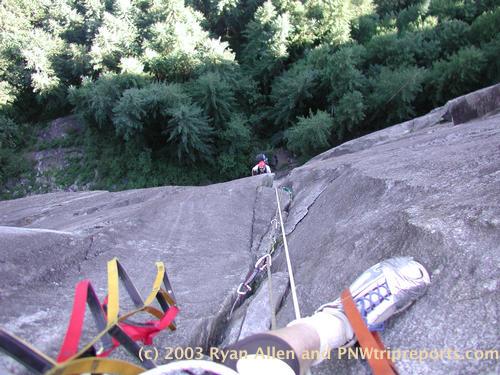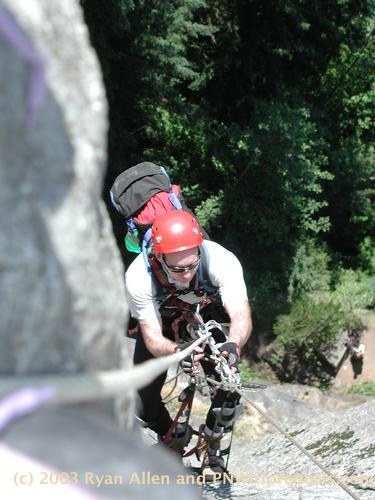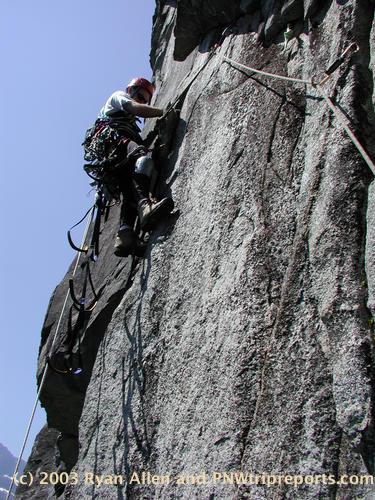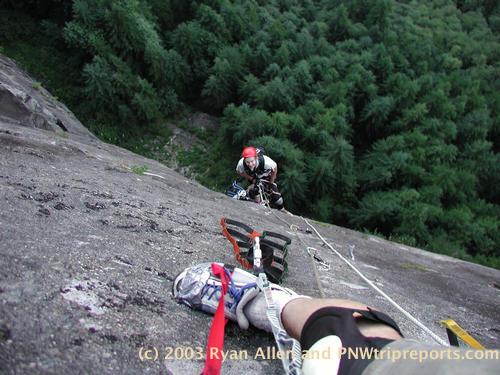📍 Towne Crier (IV, 5.9 A2), July 21, 2002
Index Upper Town Wall
ICC Alpine 3

Andrew Keleher and Ryan Allen.
Andrew, an ICC student this year has more “Big Wall” ambitions, as opposed to the typical alpine style climbing the ICC focuses on. So, on a slight divergence, we decided to try another Washington classic, the Town Crier, his first multi pitch aid route. Here’s how it went:

Saturday, 9:00 PM: met in the Index climbers parking lot to sort gear and bivvy.Sunday, 4:00 AM: Woke up from a terrible bivvy. That parking lot is the crummiest place to bivvy I can think of. Huge locomotives came screaming by every 30 to 40 minutes.4:45 AM: Headlamps on, we hit the trail.5:30 AM: Base of climb.6:00 AM: I take first lead, a beautiful 5.9 crack. I think this turned out to be my favorite pitch on the entire route! At the anchors, I hauled the heavy pack. We knew it was going to be hot, so we hauled an extra 2 liter bottle of water.Lost track of time…
Pitch 2: Andrew takes the lead up the awkward 5.8+ chimney. After he went about 30 feet off the belay without placing any pro, I asked him if he ever heard the phrase “place early and often”. I told him it would be okay, because due to the large ledge system about 10 feet below me, he would splat on the deck there in stead of submitting the anchor to a factor two fall. Chuckling lightly, he placed a cam. He rigged a hauling system, and started swearing at the difficulty in hauling, and that was a relativity light haul bag! It was an awesome lead, and the last free pitch.Pitch 3: The first aid pitch. I was a little rusty, but got in a pretty good rhythm after just a few pieces. The face leading up to the large roof had a lot of loose blocks and some pretty scary placements. Our plan was to lead under the roof, and have Andrew second aid to clean – exactly how Ambrose and I did it last year. When I got to the roof, there was only one fixed piece: an old wire hanging off a brassie with a million year old sling and a rap ring. The crack under the roof was full of moss, and looked pretty manky. On the spot, I changed the plan to go for the tension traverse.Andrew lowered me off the small brassie, and I started going for it. I wasn’t exactly sure what I was going for but I started running back and fourth to gain more momentum to get as far left as I could. All I could find was a really thin RURP seam about 10 feet to my left, which didn’t look very appealing. I had Andrew lower me more. I started swinging once again, and once again got nowhere. Okay, frustrated and even more committed, Andrew lowered me even more and I started to really swing far. On my third run, I reached as far left as I could and I grabbed a thin edge. It didn’t feel hopeful, but by bumping my hand a few times up, my hand was surprisingly swallowed into a bomber lay-back crack – what luck! Turned out to be a really fun and steep lay-back, going about 12 feet onto a great platform. From there, a mostly filled in flake that took tiny nuts and one pin to get onto the belay ledge. “So, Andrew, to you know how to follow a tension traverse?” “I’m not sure, maybe you could coach me through one?” Well, I’ve actually never done one myself, but I’ve thought about it quite a lot. So I ran him through it, and I think we both agreed that it worked “something like that”.

Jugging Past the Tension Traverse It took him a very long time to get the gear sorted and for him to start jugging. He had the weirdest ascenders I’ve ever seen, some strange Russian jobbies that looked like they had 100 moving parts. Anyway, once he got moving and cleaning, things sped up. I was waiting for him to announce the start of the lowering out, but never heard it. After awaking from my snooze in the direct sun, I looked down and saw him finishing the traverse! I guess he had enough tail to just stick the doubled over tail through the rap ring, clean the biener and batman off the doubled over tail. He never even had to untie. I guess it took him about an hour to clean, traverse and get up to me. We had to become more efficient or be doomed for some night time climbing!
Pitch 4: The triple overhang. He started off slowly, but after realizing the amount of fixed gear sped up quite a bit. He seemed very comfortable on aid lead which comes from all his practice soloing City Park. After a nice conversation with my Mom on the cell phone, he yelled “Off Belay”. I cleaned as quickly as I could, with a goal of starting my jugging within 2 minutes of him announcing the line was ready
Starting up the Triple Overhang Pitch when I met him at the hanging belay (in direct sunlight VERY HOT), the place was a mess with gear hanging everywhere. After a major sort out, We finally got all gear exchanged and I started up the next pitch. I think after that he started to get the hang of things :)Pitch 5: Was a nice, fairly straight up crack system that posed some minor aid challenges. At one point I chickened out on a sketchy cam-hook placement and went for hammering in a pin instead. A little further up I was standing on a piece that popped, right after placing the next, luckily a bomber cam. The result was about a 2 foot dynamic fall on a daisy – something I always hear you are supposed to avoid!I got to the next hanging belay and focused on organizing everything and getting ready for the gear exchange, which went very smooth, and Andrew was on his way relativity quickly.
Hanging belay halfway up the route.Pitch 6: the awkward flaring A2+ thing. We specifically brought some larger cams for this pitch, and Andrew seemed to experience little trouble getting past this thing and onto the bomber bolt ladder. He did a stellar job getting to the final hanging belay!The gear exchange went really smooth, and we seemed to finally settle into a pattern. Just in time for the final pitch!
Andrew hanging high above the trees, on the second to last pitch.Pitch 7: A short bolt ladder with some free moves to the ledge. Nothing to it, save the one free move in tennis shoes 🙂 Nothing spectacular except the exposure at this point. I accidentally dropped a biener and we watched it dropping to the ground, hitting nothing on the way down except the ground itself, some 500?? feet below. The sun started setting. That always seems to happen when I get to that ledge. Andrew jugged up, left the backpack with me, and led up the “4th class” to the top. Just as I remember, the 4th class was really challenging, perhaps the crux move of the climb involving a few weird chimney/smear/dirty gully moves inside a bush. With the backpack, haul line, most the rack and my shoes now just barely held together with duct tape, it felt like 5.10! When I met him at the top, it was completely dark. Perfect timing!

Andrew about to jumar onto the luxurious ledges on the top, after spending way too many hours on the wall.
We had our celebratory GU and final glug of water and went wondering into the woods looking for the descent trail.After wondering through the woods for a while looking for the trail, we hiked like drones down to the main trail. We had to hike back up to the base of the wall to get our gear. The wall under the nearly full moon was quite impressive, and we took a few minutes to trace our route. The wall suddenly didn’t look so scary! It was almost like we didn’t just climb it. Slightly bewildered, we headed down the rest of the trail, and made it back to the cars at an early 11:45 PM. We were both extremely tired, but felt quite good.\
Some stats:
- 7 pitches
- 5 were direct aid
- 4 hanging belays
- 19 hours, car to car
- 15.5 hours spent hanging in our harnesses
- Calories consumed: Ryan: 950 Andrew: 1200 (Look out nutra slim!)
- Water drank: Ryan: 3 quarts (complained of being thirsty all day)
- Andrew: 3 quarts, (very thirsty at top)
- Temperature: 80+ in direct sunlight, but with a nice breeze to help cool off.
- Train frequency on a Saturday night: about 1 every 40 minutes.
- Cell signal strength (at all belays): Full bars (better than at home)
